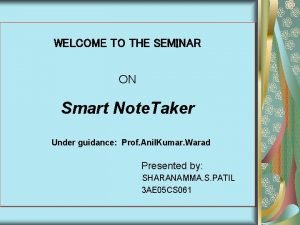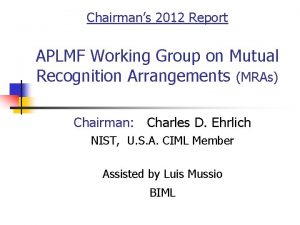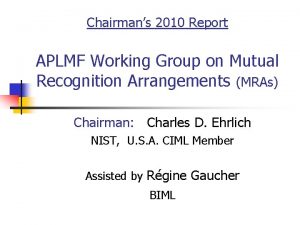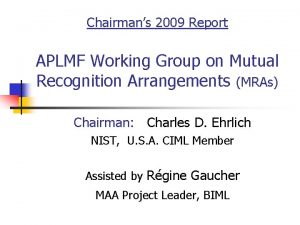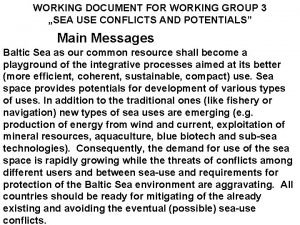Software Working Group Chairmans Note This document was











- Slides: 11

Software Working Group Chairman’s Note: This document was prepared by the “software and applications” working group and was received by the entire workshop in plenary session without modification.

Findings • What we’ve learned over the last 15 years – Successes – Challenges that have emerged in the last 15 years • Current concerns and needs for the next 5 -10 years • Impact of new hardware technologies

Five improvements in the last 15 years? • Experience with systems and some applications at largescale • Independent software vendors now support distributed memory programming paradigms, narrowing programming models • Commercial interest in exploiting multicore architectures • Opportunity to use our community experience with extreme concurrency on mesh-based applications (more generally, apps with geometric-based decompositions) • Adoption of software components in some legacy applications has provided a route for the evolution of codes in terms of algorithms, software, and even languages

Five priority challenges – emphasizing what has changed in the last 15 years? • Fault tolerance for hardware unreliability • Growth and change of the memory wall problem (latency and bandwidth) • Greater demand for application concurrency (to exist and to be exposed) • Fragility of the software stack • Relationship between commodity and HPC hardware and software

Five present concerns • Independent software vendors are not thinking at the necessary scales • Few participants from academia have access to the state of the art HPC systems • Exhaustion of precision at new application scales • (Validation and) Verification problem is becoming unavoidable and intractable • Legacy and new code present some different issues (and may need different solutions)

Impact of New Hardware Technologies • Modifications/extensions to current approaches (languages, libraries, etc. ) probably sufficient – Software doesn’t care whether digital logic uses CMOS or nanotubes – Completely different approaches should also be considered and supported as high risk, high payoff

Recommendations • Reflect three major hardware directions: – Commodity architectures following Moore’s Law to at least 2020 – Specialty/Custom Architectures – Discontinuities (e. g. , Quantum computer) • 17% per year improvement (by some metric, on some classes of apps), sustained, would have great impact – Exponential improvement is one way to create a qualitative difference from evolutionary, quantitative improvements – A software roadmap could help • Realistic targets should be drawn from application needs • Metrics must be chosen carefully to ensure solutions address classes of applications, not model problems or individual apps

Software for Commodity • Software needs to address issues of – Memory Wall – Concurrency – Interoperation with other tools – Performance comprehension – Faults and errors

Software for Specialty Architectures • In addition to commodity issues, – Algorithms and performance comprehension for unique features in specialty architectures (e. g. , techniques for streams, vectors, threads, parcels, …) – System software to lower the overall cost • Concerns about hardware – Scalar performance (and other Amdahl law effects) – More software/hardware co-design • Adoption path for legacy software and legacy software developers – What are the minimal extensions to MPI, C, and Fortran to exploit unique features? • Analogue is vector or multithread extensions to Fortran, not a new language

Discontinuities • Software that supports coprocessors – E. g. , quantum co-processor attached to conventional system – Also applies to hybrid systems (Commodity + FPGA, PIM, …) • Custom languages (such as ones for quantum computers)

Working Group Members • • • Bailey, David Bergman, Larry De. Hon, Andre Foster, Michael Fox, Geoffrey Gropp, Bill Gustafson, John Hendrickson, Bruce Jardin, Steve • • • Johnson, Fred Keyes, David Mc. Cabe, Barney Nichols, Jeff Pundit, Neil Saphir, Bill Tufo, Henry Williams, Colin Womble, David
 Difference between note making and note taking
Difference between note making and note taking Signal phrases
Signal phrases Difference between note making and note taking
Difference between note making and note taking Goods received note vs delivery note
Goods received note vs delivery note Debit note meaning
Debit note meaning What is credit note and debit note
What is credit note and debit note Note making advantages
Note making advantages Simple discount note
Simple discount note What is smart note taker
What is smart note taker Smart vs hard working
Smart vs hard working Hot and cold working process
Hot and cold working process Hot working and cold working difference
Hot working and cold working difference








